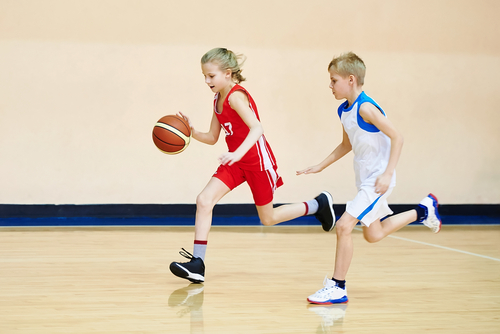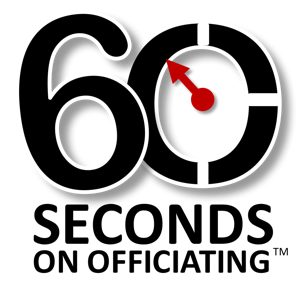
Policing Apparel and Free Throws
NFHS adds clarity to apparel – and changes to free throw rules.
The old saying that, “rules were made to be broken,” may be a catchy credo to help some people justify taking short cuts in their life; but the rule changes put forth by the National Federation for the 2014-15 basketball season were actually made to make it easier for officials to follow the rules, and do their jobs more effectively.
In previous posts we outlined the new NFHS rule on defining what illegal contact is by a defender on a ball handler or dribbler, and also reviewed the importance of ruling correctly on plays involving excessive contact…
In today’s REF 60 post we examine the enhanced changes to the rules involving uniform policing and foul lane monitoring.
Let’s take a look at both:
Team Apparel and Equipment
No longer are officials required to scrutinize the reason for, or the positioning of, arm sleeves, knee sleeves, lower leg sleeves and tights.
They are ALL now permissible and officials do not need to be concerned if there is a medical note on file for the player’s wearing a leg or arm garment.
A team has FOUR color choices for their protective sleeve attire (White, Black, Beige or the predominant color of the uniform) and EVERY player must wear the SAME color.
The same color choices and restrictions apply to players choosing to wear headbands or wrist bands…
Please note the rules for establishing the parameters for sleeves and tights (Rule 3-5-3) and headbands and wristbands (Rule 3-5-4) are separate and are to be evaluated independently of each other.
Keep in mind that knee and ankle braces, as well as protective mask masks are considered medical devices and DO NOT fall under the four color restrictions mentioned above, as long as they have not been altered in any way by the player.
And there is no change to the rule for wearing a t-shirt underneath the jersey or with compression shorts; they must both be a single solid color similar to the predominant color of the jersey and shorts.
To be clear, not every player has to wear every item should a teammate choose to outfit his/her self with a pair of tights, an arm sleeve, lower leg sleeve, wrist bands and head band. Only that whatever item is worn, they must all be the same color.
A word of advice for managing and enforcing this rule — take care of it early!
If the team you are observing in pre-game activity is not wearing a warm up jacket and/or warm up pants, then you can evaluate every item in question in the first few minutes of observing the team take the floor and you can make the player or players aware of any problems as they pass by you. If they are wearing warm up apparel, then you make sure the Referee addresses it with the the captains (and coaches where applicable) in the pre-game meeting.
This matter should be evaluated and resolved long before the players are taking the court to start the game, so take a quick peak at the benches as the teams are getting last minute instructions and preparing for the starting lineups to be introduced.
On The Release
This change from keeping players corralled in marked lane spaces until the free thrower’s attempt touched the rim should reduce the number of “gotcha” whistles and help keep the game flowing…Players will have a few more seconds to move into the lane and a bit more to legally position and compete for a rebound on a missed free throw.
This rule change DOES NOT apply to the free throw shooter or to players NOT in marked lane spaces. These players must still adhere to the “on the hit” restriction, and must wait until the ball touches the rim or backboard.
And the rules for violations committed by a free throw shooter or a lane space holder still applies.
- If a free thrower steps on or over the line before the ball touches the rim — Violation.
- If a free thrower fakes an attempt, for whatever reason — Violation.
- If a defensive player in a lane space steps in the lane before the free thrower releases the ball — DELAYED Violation Signal and whistled if free throw is missed.
- If a defensive player in a lane space steps rocks suddenly to lure an opponent to leave early — DELAYED Violation Signal and whistled if free throw is missed.
- If an offensive player in a lane space steps in the lane before the free thrower releases the ball — Violation.
- If an offensive player in a lane space steps rocks suddenly to lure an opponent to leave early — Violation.
Now whether in your personal and professional life you’re a proponent of the “rules were made to be broken” axiom, the NFHS rule changes pertaining to uniform accessories and lane space movement frees you as an official from the burden of looking for a short cut.
These two changes for the 2014-15 campaign have made your officiating duties a little easier.
NFHS Rule References
3-5-3; 3-5-4 and 9-1-3

Tim: Very good article. Just as a reminder that the sleeves rule (3-5-3) and the bands rule(3-5-4) are two separate rules, therefore, team mates can wear black headbands and white arm sleeves.
“If a free thrower steps on or over the line before the ball touches the rim — Violation.”
I interpret a step as ending when the foot returns to the floor. Would the rule be clearer if it stated “If a free thrower steps on the line or BREAKS THE PLANE before the ball touches the rim — Violation.
If a player in the lane space goes over the foul shooters line before the ball hits the rim is it a violation?